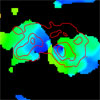- Eric Keto's Home Page
- High Mass Stars
- Starless Cores
- Extragalactic
- Radiative Transfer
- Hydrodynamics
- SMA Instrumentation
- IR Instrumentation
- MOLLIE radiative transfer
- Keto Prize
- Textbooks
|
The Formation of Stars and Clusters in Galaxies
| ||||
|
Abstract We observed the nearby starburst galaxy M82 in CO in the higher frequency (2--1) transition to achieve an angular resolution below 1 arc second or 17 pc at the target. We resolved the molecular gas into a large number of compact clouds, with masses ranging from 2 x 10^3 to 2 x 10^6 solar masses. The mass spectrum N(M) scales as M^-1.5 +- 0.1, similar to the mass spectra of young massive star clusters suggesting that individual molecular clouds are transformed in the starburst into individual star clusters. The larger clouds are surrounded by supernovae and HII regions suggesting that star formation proceeds from the outside of the clouds and progresses inward consistent with triggering by a sudden increase in external pressure. The clouds with internal star formation have velocity gradients and inverse P-Cygni spectral line profiles indicating inward motions of 35 kms consistent with shock driven compression. Diffuse free-free radio emission and X-ray emission around the clouds provides evidence for superheated ionized gas sufficient to drive the compression. Clouds with spectral lines indicating expansion show little internal star formation suggesting that the dynamics precedes and is responsible for the star formation rather than the inverse. M82 is known to be in interaction with neighboring M81. The overall picture is consistent with the formation of massive star clusters from individual giant molecular clouds crushed by a sudden galactic scale increase in external pressure generated by the changing dynamics that result from a near-collision with a neighboring galaxy. Present day globular clusters may have formed in a similar fashion in primordial galaxies. Eric Keto, Luis C. Ho & K.-Y. Lo, 2005, ApJ, 635, 1062
Abstract The fine-structure lines of singly (NeII 12.8 micron) and doubly (NeIII 15.6 micron) ionized neon are among the most prominent features in the mid-infrared spectra of star-forming regions, and have the potential to be a powerful new indicator of the star formation rate in galaxies. Using a sample of star-forming galaxies with measurements of the fine-structure lines available from the literature, we show that the sum of the NeII and NeIII luminosities obeys a tight, linear correlation with the total infrared luminosity, over 5 orders of magnitude in luminosity. We discuss the formation of the lines and their relation with the Lyman continuum luminosity. A simple calibration between star formation rate and the NeII + NeIII luminosity is presented. Luis C. Ho & Eric Keto, 2007, ApJ, 658, 314
| ||||
|
|


